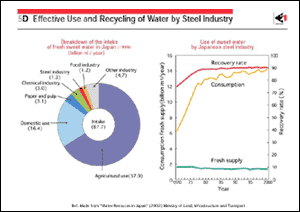The steel industry has become more
efficient in both the use and recycling of water to combat pollution.
The daily average water intake in Japan is classified by usage
on the left side of the figure. Agriculture is the largest water
consumer, accounting for 160 million m3,
followed by domestic water and industrial water, each accounting
for over 40 million m3.
Of industrial water, the fresh supply by the steel industry is
about 3.8 million m3 on
a daily average basis. This is less than that taken by the paper
and pulp industry, or by the chemical industry. However, the
aggregate quantity actually used by the steel industry is as
high as 38 million m3.
The large discrepancy between the consumption and the quantity
taken is due to the recovery and recycling of the water taken
in by steel works.
The right side of the figure shows a comparison among the consumption,
the fresh supply, and recovery rate of fresh water by the steel
industry in Japan. In the 1970s, the quantity of water used increased
greatly. However, increasing the rate of recovery and the amount
of recycling has resulted in a small decrease in fresh supply,
despite increasing production.
To produce one metric ton of crude steel requires about 150 m3
of water, of which about 90% is used for cooling. Cooling water,
including gas-cleaning water, contains suspended solids such
as fine scale and dust, and is re-treated by sedimentation, coagulating-sedimentation,
or filtration. Water containing oil, which is discharged from
the rolling processes, is re-treated to remove the oil by spontaneous
flotation, filtration, or coagulating pressurized-air flotation.
The recovered oil is then reused as fuel oil, etc. Water discharged
from the pickling, electrolytic cleaning and galvanizing lines
contains acids, alkalis, and metals such as iron, chromium and
zinc. The water containing a high concentration of acid or alkali
is recycled, but water with low concentrations is neutralized.
These metals are removed by coagulating sedimentation or by ion-exchange. |
|
 |
 |
 |
|
|